Exploring Autism Spectrum Disorder Prevention and Support
Autism Spectrum Disorder (ASD) is a complex neurodevelopmental condition influenced by genetic and environmental factors. While there is currently no known cure for autism, early diagnosis and evidence-based interventions can significantly improve outcomes for individuals on the spectrum. This article delves into scientific approaches, especially behavioral therapies such as Applied Behavior Analysis (ABA), alongside emerging insights into prevention strategies. We explore how timely support, personalized therapy, and family involvement can enhance communication, social skills, and adaptive behaviors, contributing to better life quality and potentially mitigating symptoms. Understanding how to proactively address autism is crucial for families, professionals, and communities alike.
What Is Applied Behavior Analysis (ABA) Therapy?
What is Applied Behavior Analysis (ABA) therapy?
Applied Behavior Analysis (ABA) therapy is a scientifically validated method that focuses on understanding and changing behavior. Rooted in foundational learning theories like operant and classical conditioning, ABA aims to support individuals, especially children with autism spectrum disorder (ASD), by encouraging helpful skills while reducing unwanted behaviors.
How does ABA leverage learning theory?
ABA uses principles from learning theory, emphasizing the connection between antecedents (what happens before a behavior), the behavior itself, and its consequences (rewards or corrections). This ABC model helps tailor interventions that teach new skills or modify existing behaviors effectively through positive reinforcement and structured practice.
How are ABA programs personalized?
Each ABA program is designed based on detailed assessments by Board Certified Behavior Analysts (BCBAs). These programs are highly individualized to address the unique strengths, challenges, and preferences of each person. Treatment goals can range across communication development, social interaction, self-care, play, academic skills, and behavior management.
What techniques are commonly used in ABA?
ABA incorporates various teaching styles and interventions. One well-known technique is Discrete Trial Training (DTT), which breaks skills into small, manageable steps taught with clear instructions and immediate rewards. Naturalistic approaches like the Early Start Denver Model (ESDM) blend behavioral principles with developmental strategies in everyday settings, using playful and social exchanges to foster learning.
What is the evidence base and recognition for ABA?
ABA therapy has a robust evidence base, recognized by institutions such as the US Surgeon General and the American Psychological Association. Research demonstrates its effectiveness in improving IQ, language, adaptive behaviors, and social skills in individuals with ASD. Early and intensive ABA interventions, often delivered over multiple hours weekly, show medium to large effect sizes. Additionally, ABA continues to evolve by integrating naturalistic and pivotal response techniques, maintaining its reputation as the gold standard treatment for autism.
How ABA Therapy Benefits Individuals with Autism
Behavior Modification Benefits
Applied Behavior Analysis (ABA) therapy systematically promotes positive behaviors and reduces challenging ones by understanding the context and consequences of behaviors. Using techniques like positive reinforcement, ABA encourages desired actions through rewards, helping individuals with autism adopt adaptive behaviors more effectively.
Enhancement of Communication and Social Skills
ABA supports the development of communication by breaking skills into manageable steps and reinforcing correct responses. Specific programs such as Naturalistic Developmental Behavioral Interventions (NDBI) and Pivotal Response Training (PRT) foster language use and social engagement in natural settings, leading to medium to large improvements in communication and social interaction.
Development of Daily Living Skills
ABA also targets daily living abilities such as self-care, toileting, and eating through methods like shaping, scheduled routines, and stimulus control. These interventions build independence in routine tasks, essential for better quality of life and greater social inclusion.
Evidence of Developmental Gains from Early and Intensive Intervention
Early Intensive Behavioral Intervention (EIBI), a comprehensive form of ABA typically started before age 3, has been shown in studies to significantly enhance IQ, language, adaptive behaviors, and social communication. This early and sustained therapy maximizes developmental outcomes and supports lifelong skill acquisition.
| Aspect | ABA Approach | Outcomes Achieved |
|---|---|---|
| Behavior modification | Positive reinforcement, A-B-C analysis | Reduction of harmful behaviors, increased compliance |
| Communication and social skills | NDBI, PRT, ESDM | Improved language, social interaction, imitation |
| Daily living skills | Shaping, stimulus control, scheduled toileting | Enhanced independence in self-care and routines |
| Early intervention | EIBI starting before age 3 | Significant IQ gains, better adaptive skills |
Who Provides ABA Therapy? Qualifications and Expertise
Professional Roles in ABA
ABA therapy is delivered by a team of qualified professionals. The primary providers include Board Certified Behavior Analysts (BCBAs), licensed behavior therapists, and trained ABA paraprofessionals. These individuals collaborate to develop, implement, and monitor behavioral interventions tailored to each individual's needs.
Qualifications of Board Certified Behavior Analysts (BCBAs)
BCBAs hold a master's degree in applied behavior analysis or related fields. Their training includes completing between 1,500 and 2,000 hours of supervised fieldwork. To earn the BCBA certification, candidates must pass a comprehensive exam that assesses their knowledge and skills in behavioral assessment, intervention, and ethical considerations.
Training and Experience Requirements
Beyond achieving certification, ABA providers must maintain licensure through ongoing continuing education. This ensures they remain up to date on best practices and research advances. Training emphasizes data-driven approaches, including behavioral assessment, interpretation of the antecedents-behaviors-consequences (A-B-C) model, and use of reinforcement techniques.
Settings Where ABA Is Delivered
ABA therapy is offered in diverse environments, such as schools, specialized clinics, hospitals, and private practices. Many therapists also train parents and caregivers to implement ABA strategies at home, ensuring consistency and maximizing treatment efficacy. Telehealth services are an emerging modality expanding access to ABA support.
| Provider Role | Qualifications | Primary Responsibilities |
|---|---|---|
| Board Certified Behavior Analyst (BCBA) | Master's degree, supervised fieldwork, certification exam | Designs and oversees individualized ABA programs |
| Licensed Behavior Therapist | Varies by region, often with certification | Implements ABA interventions under BCBA supervision |
| ABA Paraprofessional | On-the-job training or specified coursework | Assists with direct therapy and data collection |
ABA providers possess extensive expertise in behavioral science and deliver evidence-based, personalized interventions that promote meaningful improvements in communication, social skills, and adaptive behaviors.
Common Techniques and Approaches in ABA Therapy
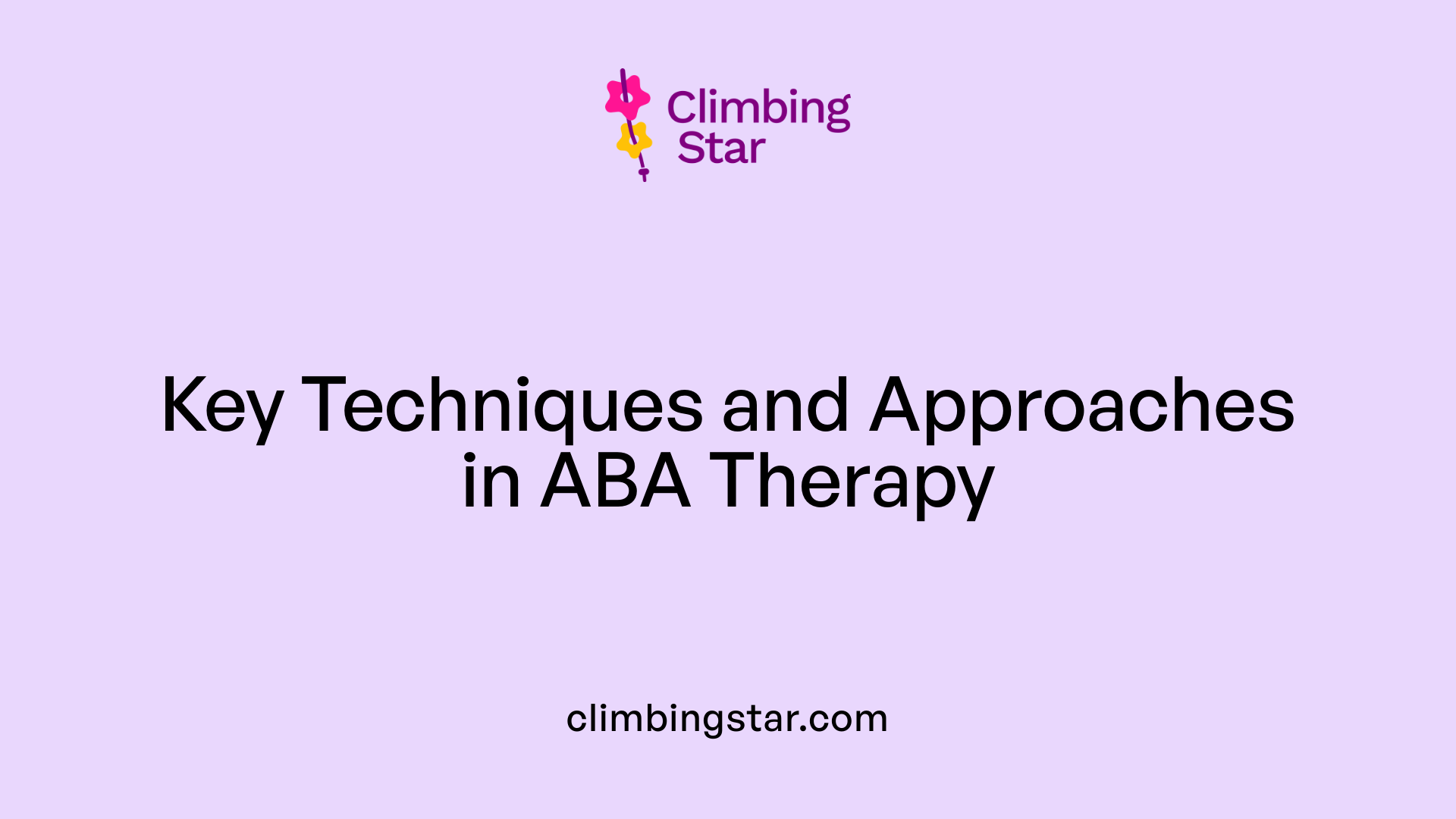
What techniques are commonly used in ABA therapy?
ABA therapy utilizes a variety of evidence-based techniques designed to promote skill acquisition and reduce challenging behaviors.
Discrete Trial Training (DTT) is a highly structured method where skills are broken down into small, manageable components. Each trial involves a clear instruction, a prompt if needed, and a response followed by reinforcement. This repetitive, step-by-step teaching helps build foundational skills efficiently.
Pivotal Response Training (PRT) is a more naturalistic, play-based approach targeting pivotal areas such as motivation and initiating communication. PRT is conducted in both clinical and home environments to generalize skills across contexts.
Natural Environment Teaching (NET) involves teaching skills through everyday activities and natural interactions, making learning more relevant and engaging for the individual.
Prompting techniques are used to encourage correct responses, gradually faded to promote independence. For example, a therapist might initially give full physical assistance and then reduce assistance over time.
Reinforcement strategies, particularly positive reinforcement, reward desired behaviors to increase their frequency. Conversely, extinction methods reduce undesirable behaviors by withholding reinforcement.
Additional strategies include modeling behaviors for imitation, chaining complex tasks by linking simple steps, and using behavior contracts or scripts to guide expectations and responses.
Together, these techniques are customized based on functional assessments to meet individual needs, ensuring effective and meaningful progress in therapy.
Measuring the Effectiveness of ABA Therapy
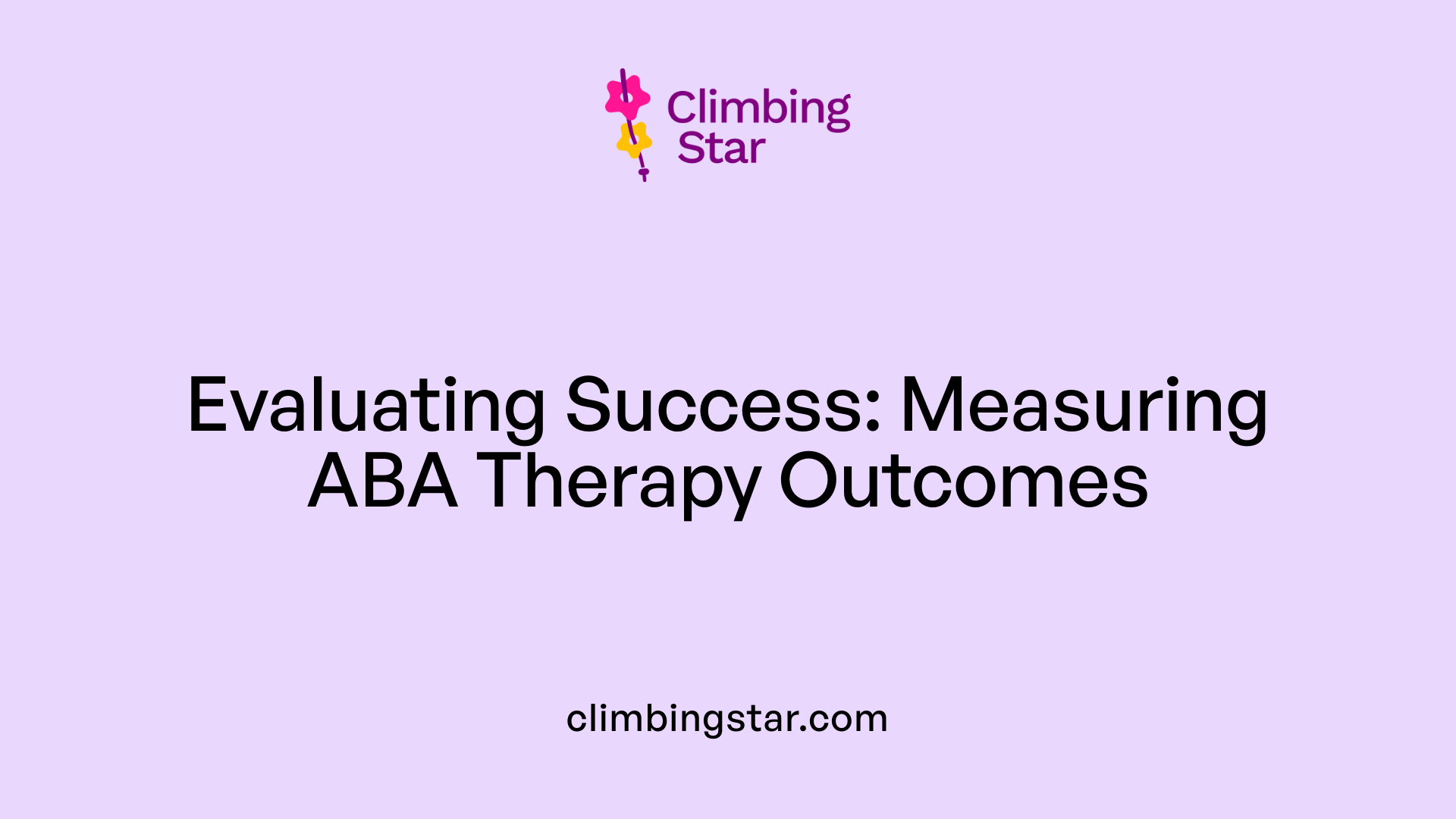
How is the effectiveness of ABA therapy measured?
Effectiveness in Applied Behavior Analysis (ABA) therapy is gauged through detailed behavioral data collection that tracks an individual's progress in acquiring or reducing target behaviors. Therapists systematically record antecedents, behaviors, and consequences (A-B-Cs), using this data to tailor and refine intervention strategies.
Standardized assessment tools play a crucial role in objectively measuring treatment outcomes. The Vineland Adaptive Behavior Scales assess improvements across communication, daily living, socialization, and motor skills, while the Verbal Behavior Milestones Assessment and Placement Program (VB-MAPP) evaluates verbal communication and language milestones relevant to children with autism spectrum disorder (ASD).
Treatment intensity, reflected in the weekly hours of therapy, influences efficacy. Research suggests that higher dosages, particularly for young children under age 5, correlate with greater gains in IQ, adaptive behavior, and communication skills. Individualized treatment plans consider these intensity factors to optimize results.
Empirically validated tools like the Problem-Oriented Planning for Children (POP-C) scale further assist clinicians by evaluating patient-specific factors such as IQ, social avoidance, and challenging behaviors. This informs decisions on treatment dosage and methodologies tailored to individual needs.
By combining continuous behavioral data monitoring, standardized assessment scores, and personalized treatment intensity, clinicians can comprehensively evaluate and adjust ABA therapy to maximize beneficial outcomes for individuals with ASD.
Early Intensive Behavioral Intervention (EIBI): Timing and Impact
What is the EIBI framework and its duration?
Early Intensive Behavioral Intervention (EIBI) is a specialized form of Applied Behavior Analysis (ABA) designed to support children with Autism Spectrum Disorder (ASD). This intervention typically begins before the age of 3 and continues intensively for a period of 2 to 4 years. EIBI employs systematic teaching methods aimed at enhancing a variety of developmental skills.
Which skill domains does EIBI target?
EIBI focuses on improving multiple essential areas of development. These include:
- Language acquisition and communication skills
- Cognitive abilities
- Self-help and daily living skills
- Social interaction capabilities
What improvements have studies reported?
Research consistently shows that EIBI can lead to significant gains for children with ASD. Notably, studies report enhancements in:
- IQ scores, reflecting better cognitive functioning
- Adaptive behaviors, helping children manage daily tasks more effectively
- Both receptive and expressive language skills, improving understanding and verbal communication
Some studies have found medium to large effect sizes particularly in social and communication domains, highlighting EIBI's robustness in these critical areas.
Why is an early start before age 3 important?
Beginning EIBI before age 3 takes advantage of a crucial developmental window when the brain exhibits high plasticity. Early intervention increases the potential for meaningful and lasting behavioral changes, allowing children to build foundational skills as they grow.
What does multiple study evidence suggest?
Numerous studies from varied sources affirm the effectiveness of EIBI. These collectively support its role in producing positive developmental outcomes across multiple skill areas and underscore the importance of early and intensive application.
Overall, EIBI stands as an evidence-backed approach promoting meaningful improvements in children with ASD when initiated early and delivered consistently over several years.
Naturalistic and Developmental Behavioral Interventions
What are Naturalistic Developmental Behavioral Interventions (NDBI)?
Naturalistic Developmental Behavioral Interventions, or NDBIs, blend behavioral and developmental strategies to support children with autism in natural settings like homes and playgrounds. These approaches focus on enhancing social communication, language, and imitation skills through everyday interactions rather than structured drills.
How does the Early Start Denver Model (ESDM) fit into NDBI?
The Early Start Denver Model is a prominent NDBI designed for young children, typically aged 12–48 months. It combines ABA principles with developmental methods to boost social, language, and cognitive skills. ESDM therapists and parents engage children in play-based activities that promote shared attention and social exchanges.
How do these approaches integrate behavioral and developmental principles?
NDBIs integrate behavioral techniques such as reinforcement and prompting with developmental focuses like joint attention and social engagement. This integration helps create a natural learning environment, encouraging the child’s motivation and responsiveness within meaningful routines and play.
What improvements have been observed through NDBI and ESDM?
Research shows moderate positive effects of NDBIs, including ESDM, on language acquisition, imitation, and social communication in children with autism. These improvements reflect the value of combining structured behavioral strategies with supportive developmental contexts.
Addressing Challenging Behaviors Through Functional Approaches
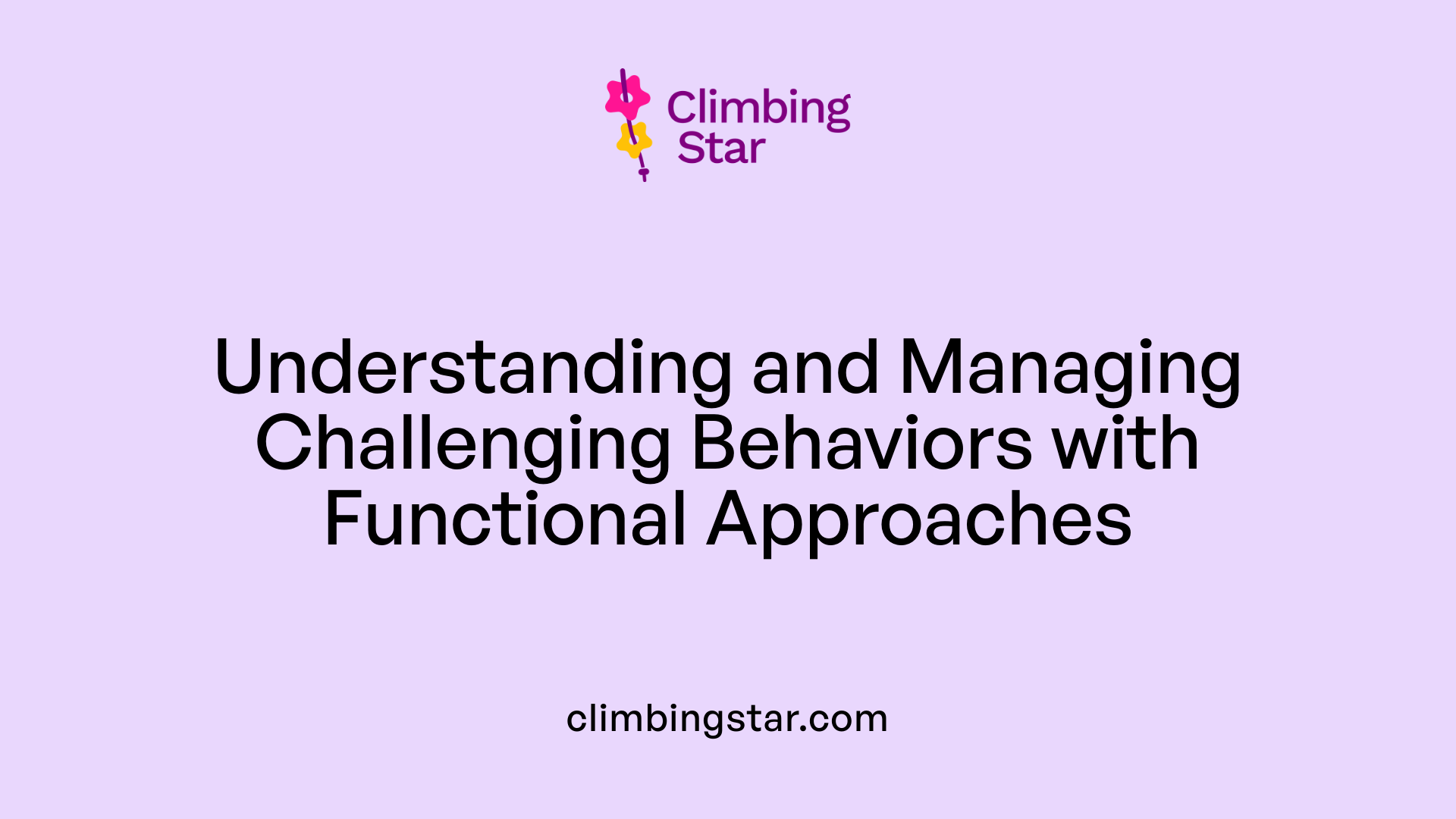
What are the Antecedents, Behaviors, and Consequences (ABC) in Behavioral Interventions?
Understanding the ABCs is fundamental in addressing challenging behaviors in individuals with autism spectrum disorder (ASD). Antecedents are events or triggers that occur before a behavior; behaviors are the actions or responses themselves; and consequences are what follow the behavior. By analyzing this sequence, therapists can tailor interventions that effectively target undesired behaviors and reinforce positive ones.
How are Functional Behavior Assessments (FBA) Utilized?
Functional Behavior Assessments (FBA) are systematic evaluations that identify the reasons behind challenging behaviors. These assessments gather information about the ABCs through observations and interviews, helping to understand the function that the behavior serves for the individual. FBAs guide crafting individualized and effective treatment plans by pinpointing what triggers and maintains problematic behaviors.
What Replacement Strategies are Used, Such as Functional Communication Training (FCT)?
Replacement strategies involve teaching alternative, appropriate behaviors to fulfill the same needs as challenging behaviors. Functional Communication Training (FCT) is a prominent approach where individuals learn to use effective communication methods—such as gestures, signs, or verbalizations—to replace problematic behaviors. This reduces frustration and enhances social interaction by providing functional ways to express needs.
How Are Preventative, Replacement, and Response Strategies Integrated?
Effective behavioral interventions combine prevention, replacement, and response strategies for comprehensive support. Prevention techniques—like visual schedules and priming—minimize triggers by making environments more predictable. Replacement strategies teach new skills to replace challenging behaviors. Response strategies involve reinforcing desired behaviors and applying extinction to reduce undesired ones. This integration maximizes positive outcomes by addressing behavior from multiple angles.
What Role Do Behavior Extinction and Reinforcement Play?
Behavior extinction involves withholding reinforcement for undesirable behaviors so they decrease over time. Concurrently, positive reinforcement rewards desirable behaviors to encourage their repetition. By balancing these techniques, therapists can reduce challenging behaviors while promoting skill acquisition and adaptive functioning in natural and clinical settings.
Parent-Mediated and Family Involvement in Behavioral Therapy
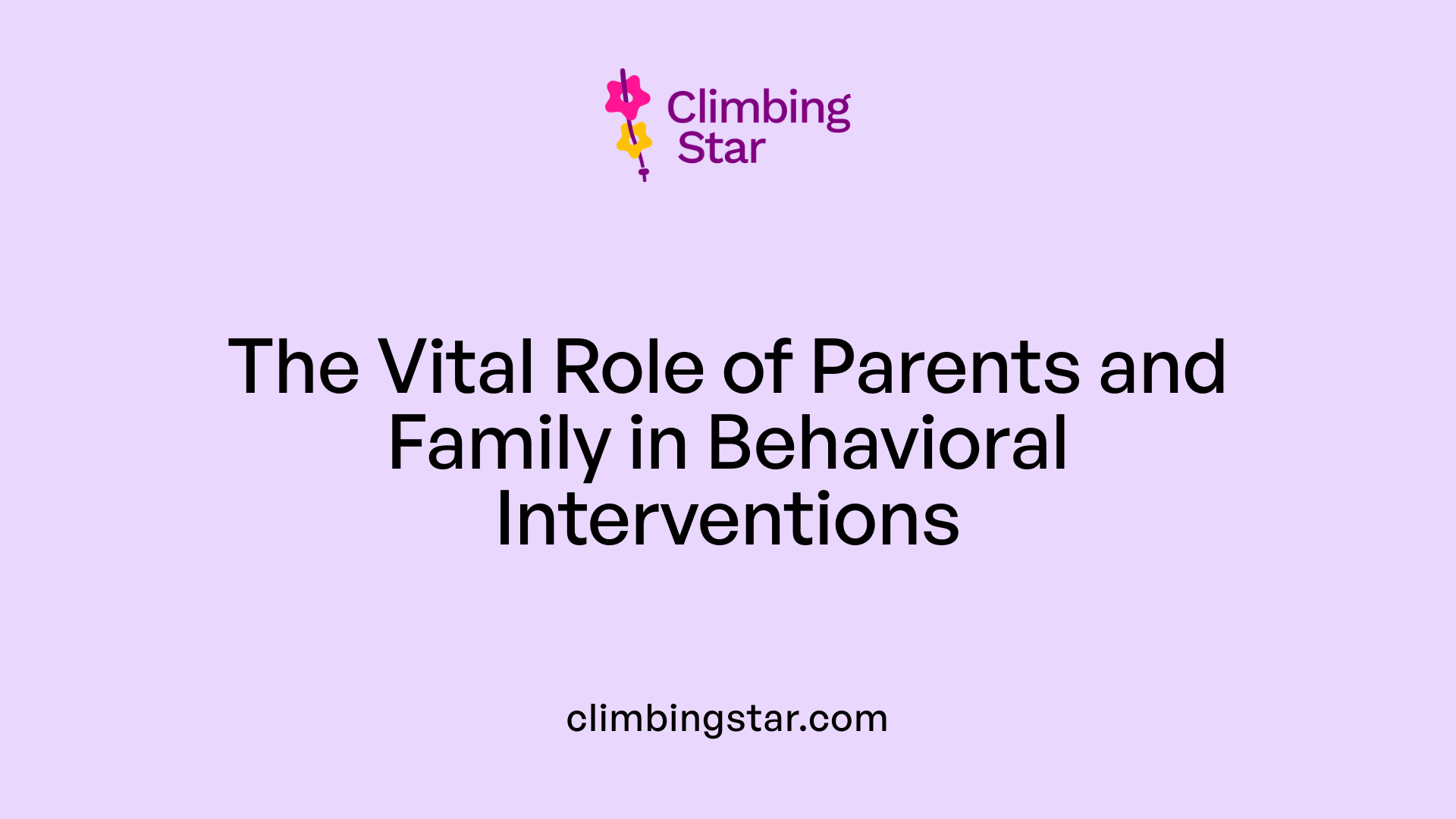
How are parents trained in behavioral techniques?
Parent-mediated interventions (PMI) focus on training parents to use behavioral techniques effectively with their children. These interventions teach parents to implement strategies grounded in Applied Behavior Analysis (ABA), including reinforcing desired behaviors and managing challenging ones. Parents learn how to break down skills into manageable steps, deliver prompts, and use positive reinforcement to encourage progress.
What are the benefits of parent involvement in early intervention and behavior management?
Involving parents enhances the consistency and effectiveness of therapy. Early intervention supported by parents promotes the development of communication, social, and daily living skills in natural settings, helping children generalize learning. Parent-mediated approaches lead to improved management of challenging behaviors and support children's overall development.
How does family involvement influence stress and engagement?
Training parents empowers them with skills to support their child, which not only improves treatment outcomes but also reduces parental stress. Increased understanding and competence boost parental confidence and engagement throughout the intervention process, creating a more supportive home environment.
Can these interventions be delivered remotely via telehealth?
Recent adaptations of PMI via telehealth have shown promise, providing parents access to training and coaching without needing in-person visits. Telehealth-delivered interventions maintain the effectiveness of traditional methods and increase accessibility, especially for families living in remote or underserved areas.
Overall, parent-mediated interventions are a vital component of behavioral therapy in autism, integrating family involvement to extend the benefits of treatment and promote sustainable progress.
Complementary Therapies: Speech, Occupational, and Cognitive Behavioral Therapy
Speech Therapy for Communication Enhancement
Speech therapy is a common complementary treatment for individuals with autism spectrum disorder (ASD) that focuses on improving the understanding and use of various communication methods. This includes spoken language, sign language, gestures, or electronic aid devices. Speech therapists work to develop receptive and expressive language abilities, essential for enhancing social interaction and daily functioning.
Occupational Therapy for Independence and Sensory Integration
Occupational therapy assists individuals with ASD in gaining greater independence by teaching essential life skills such as dressing, eating, bathing, and social engagement. Additionally, occupational therapy often incorporates sensory integration therapy, which addresses difficulties some individuals encounter with sensory input that can be overwhelming or restrictive, thereby improving their ability to function in daily environments.
Cognitive Behavioral Therapy for Emotional Regulation
Cognitive Behavioral Therapy (CBT) is effective for adolescents and adults with autism who have adequate verbal and cognitive abilities. CBT targets emotional challenges such as depression, anxiety, and anger, equipping individuals with strategies to better manage and regulate their emotions in various social and personal contexts.
Adaptations for Adolescents and Adults
While many therapies begin in early childhood, adaptations of these complementary therapies cater to adolescents and adults with ASD, particularly in addressing emotional regulation and the complex social challenges during transition to adulthood. Continued support through CBT and occupational therapy can improve quality of life, facilitate better social interactions, and support greater autonomy.
Genetic and Environmental Factors Influencing Autism Risk
What are some monogenic syndromes and polygenic interactions associated with autism?
Autism Spectrum Disorder (ASD) has genetic underpinnings involving both monogenic syndromes and polygenic interactions. Monogenic syndromes linked to ASD include fragile X syndrome and Rett syndrome. These involve mutations in single genes that significantly impact brain development and synaptic functions. In addition, polygenic interactions—comprising multiple genes and genetic loci—contribute to the complexity of autism by affecting various neurodevelopmental pathways.
Which environmental exposures during pregnancy can affect autism risk?
Environmental factors during pregnancy also play a role in autism risk. Exposure to pollutants, infections, and nutritional deficiencies have been associated with increased likelihood of developing ASD. These factors can interact with a fetus’s genetic susceptibility, potentially influencing brain development and contributing to the risk of autism.
How do genetics and environment interact to influence autism?
The interaction between genetics and environment is critical in understanding autism etiology. Genetic predispositions may heighten sensitivity to prenatal environmental exposures. This gene-environment interplay shapes neurodevelopmental outcomes, explaining why some children with certain genetic risks develop autism only when combined with specific environmental triggers.
What emerging precision medicine and biotechnology approaches may impact autism treatment?
Future strategies emphasize precision medicine tailored to individual genetic and environmental profiles. Emerging biotechnologies such as gene editing, stem cell therapies, and biomarker development hold promise for targeted prevention and treatment. These advances aim to refine interventions based on a person’s unique biological makeup, potentially improving outcomes and enabling more personalized therapies.
Supporting Families and Future Perspectives in Autism Care
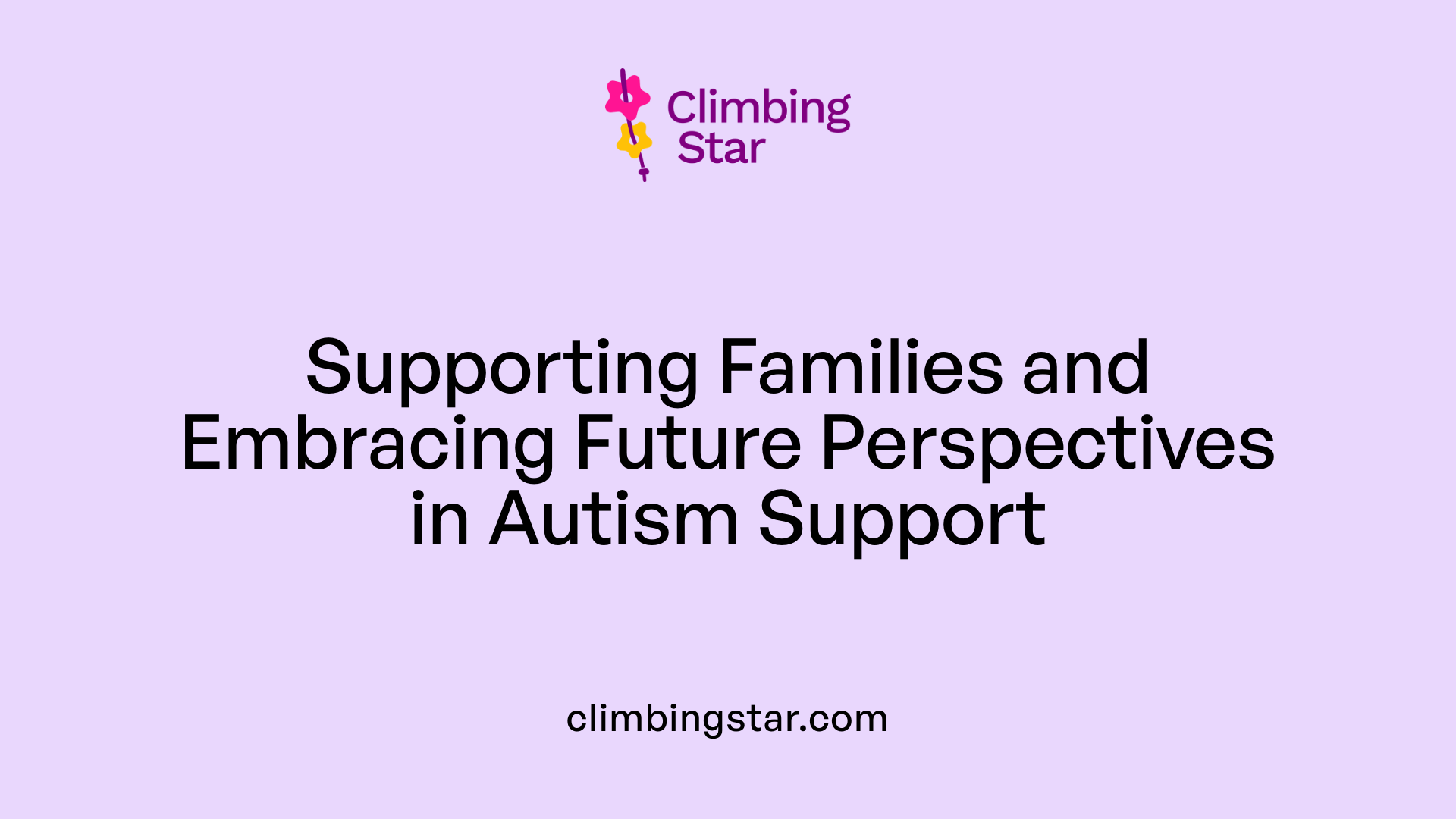
Why is a multidisciplinary health team important for families managing autism?
Families benefit greatly from assembling a multidisciplinary team of health professionals who provide comprehensive care tailored to their child's diverse needs. This team typically includes behavior analysts, speech and occupational therapists, pediatric neurologists, developmental pediatricians, psychologists, and social workers. Coordinated care enables thorough assessments, individualized treatment planning, and consistent monitoring of progress.
How can education and peer support help families?
Educating families about autism and available interventions empowers them to actively participate in their child's treatment. Training in behavioral approaches like Applied Behavior Analysis (ABA) equips parents with strategies to support learning and manage behaviors at home. Peer support groups offer emotional encouragement and a platform for sharing experiences, reducing isolation and stress.
What emerging therapies and biotechnologies show promise for autism?
Future strategies in autism care include precision medicine focusing on personalized treatments based on genetic and environmental profiles. Emerging biotechnologies involve gene editing tools, stem cell therapies, and biomarker development aimed at targeted prevention and intervention. Although research is ongoing, these advances could revolutionize autism treatment in the coming years.
What challenges do teens and adults with autism face, and what ongoing care is needed?
Transitioning to adulthood presents difficulties such as navigating social complexities, understanding bodily changes, and achieving independence. Ongoing support is essential, encompassing life skills training, vocational guidance, and mental health services. Tailored interventions help maintain gains made during childhood and address evolving needs.
Families supporting a member with autism often require continuous guidance and resources. Building a strong support network, staying informed about innovative therapies, and collaborating with a multidisciplinary team create a foundation for improved quality of life and future advancements in care.
The Role of Evidence-Based Interventions in Autism Prevention and Support
While autism spectrum disorder currently cannot be prevented or cured, early identification combined with scientifically supported interventions like ABA therapy offers the greatest hope for improving developmental outcomes. Tailored behavioral approaches, intensive early intervention, and active family involvement promote meaningful gains in communication, social skills, and independence. Advances in understanding the genetic and environmental influences on autism will continue to shape precision prevention strategies and novel treatments. Ultimately, comprehensive care that integrates behavioral, developmental, and medical support empowers individuals with autism and their families to lead fulfilling lives.
References
- Behavioral Interventions for Autism Spectrum Disorder
- Treatment and Intervention for Autism Spectrum Disorder
- Applied Behavior Analysis (ABA)
- New advances in the diagnosis and treatment of autism ...
- Treatment for Behavioral Issues in Autism
- Autism spectrum disorder - Diagnosis and treatment
- Behavioral Therapy for Autism Spectrum Disorder in Children
- Skill-based treatment for challenging behavior in autism ...
- How to Become an ABA Therapist - School of Education
- How to Become an Applied Behavior Analyst (ABA) Therapist







